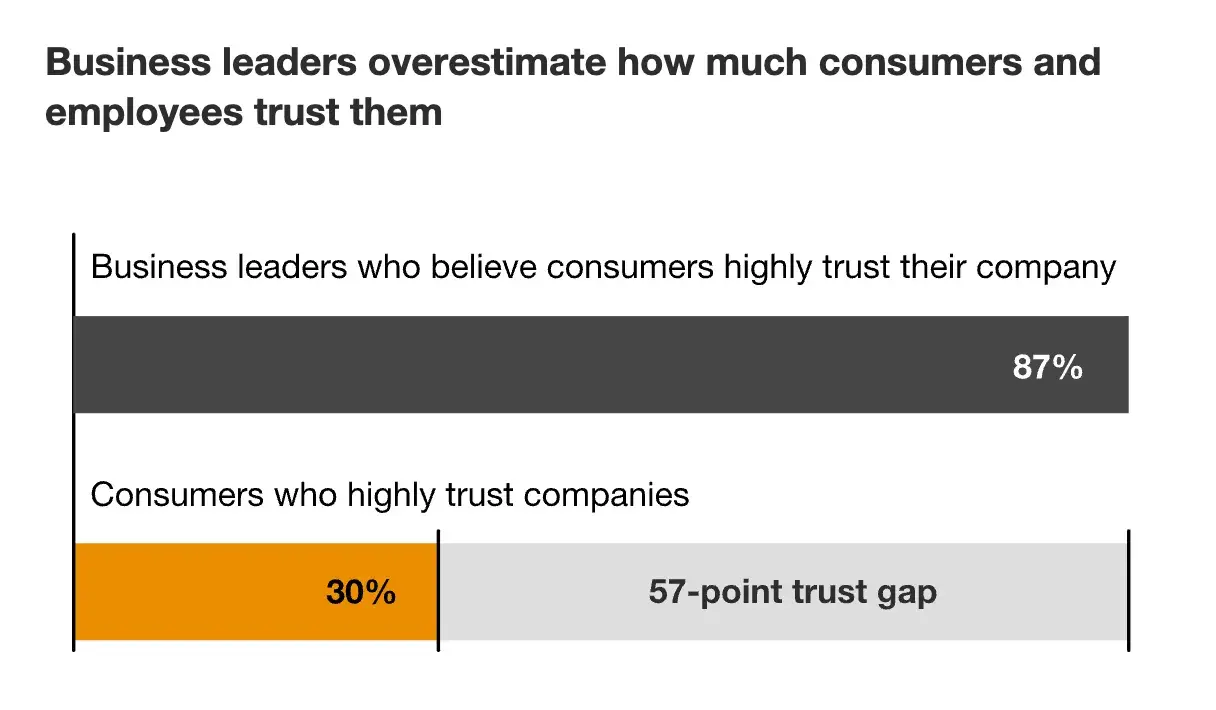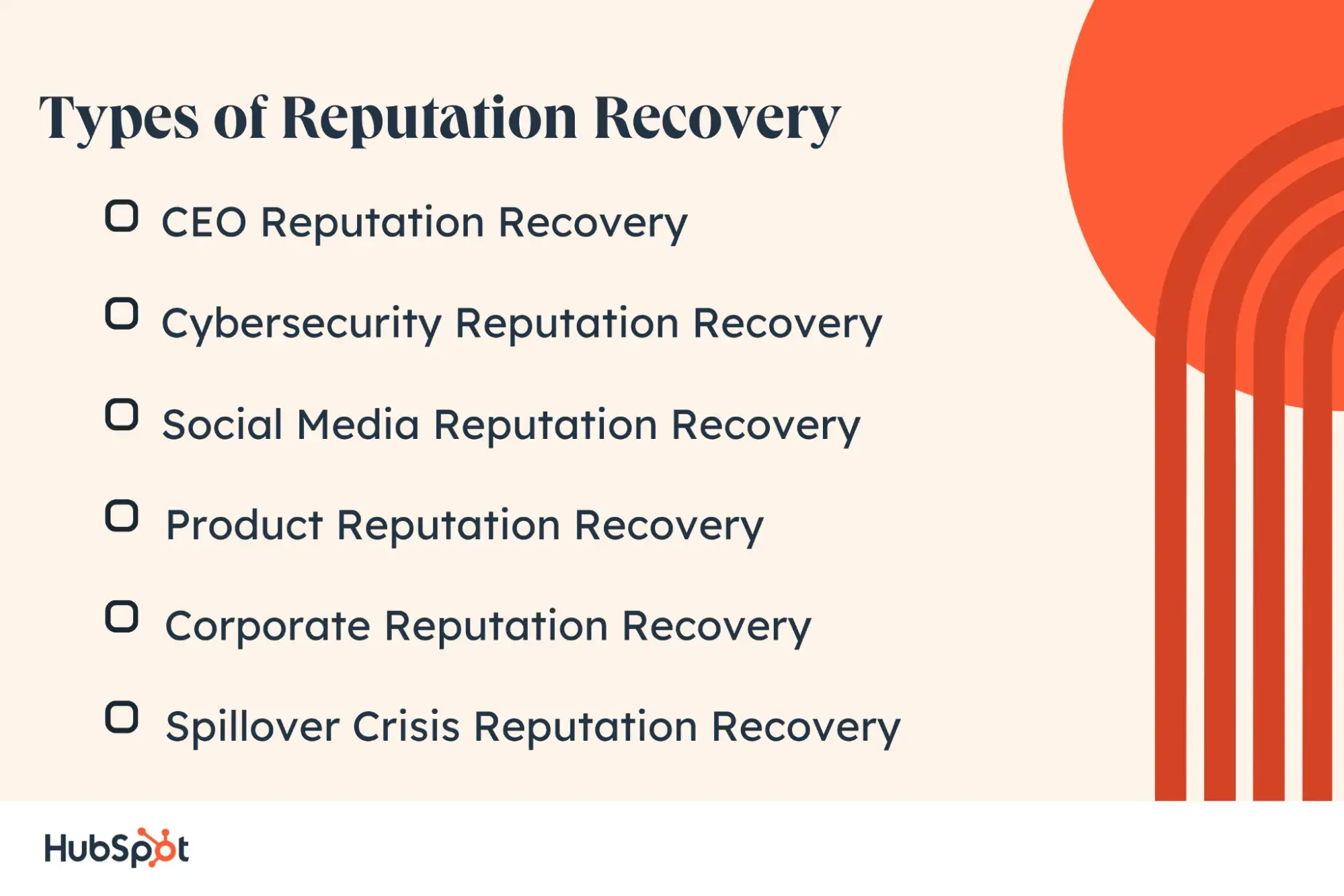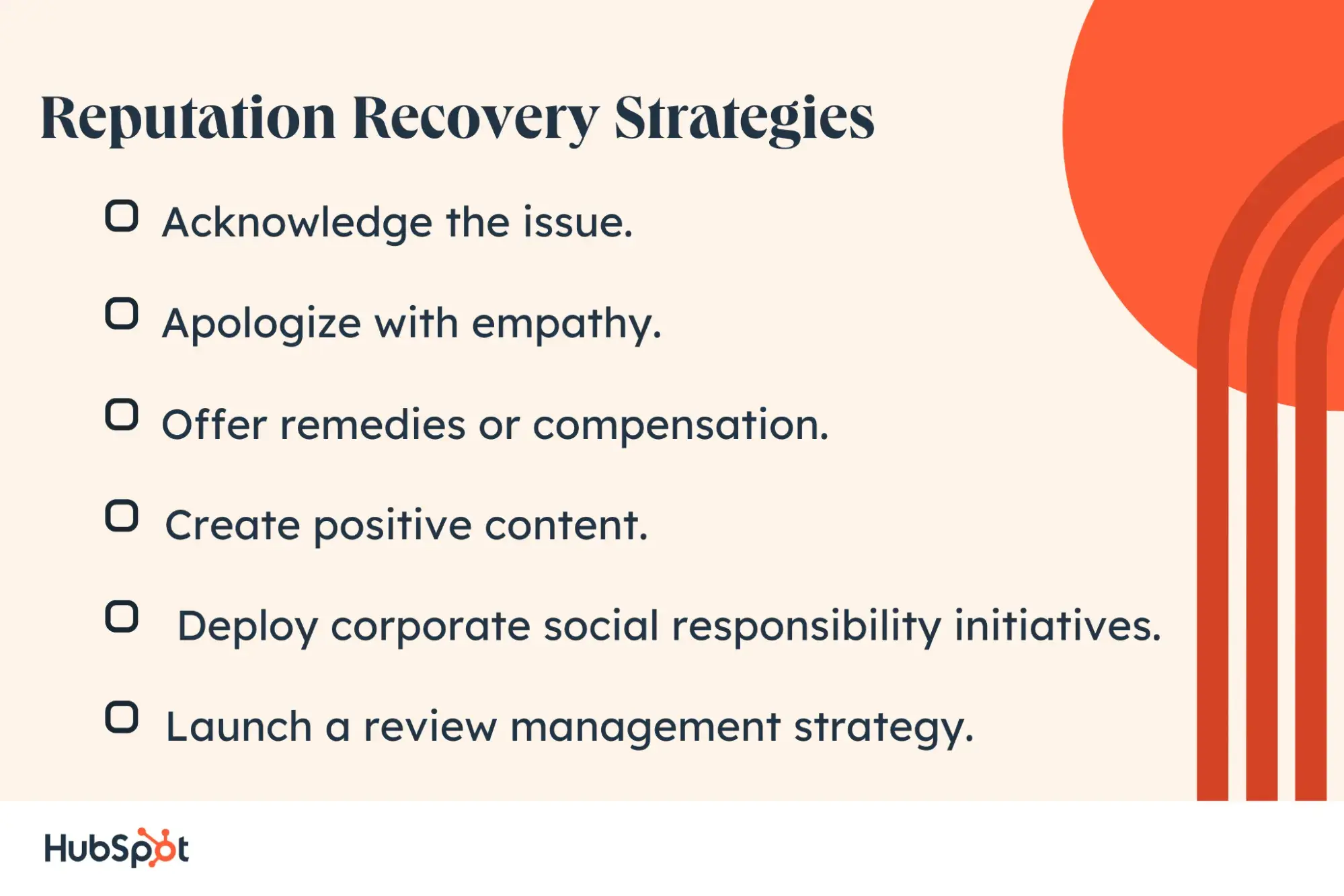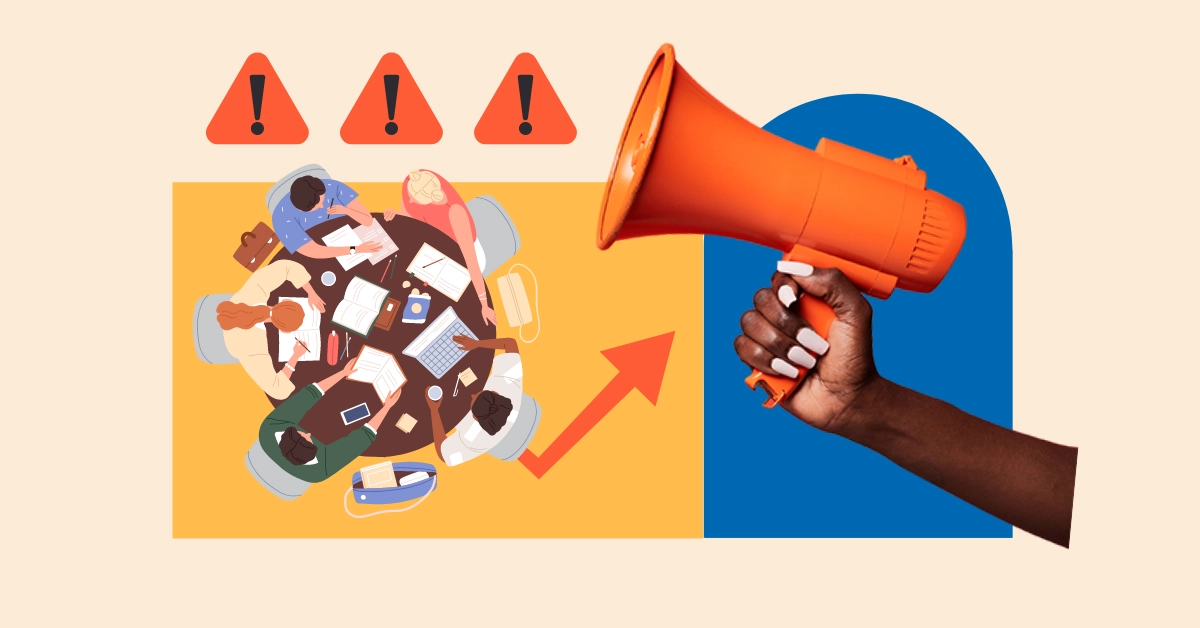Sir Richard Branson famously said, “All you have in business is your reputation.” A reputation at its core is trust. How much do your customers trust you?
Trust in brands is going down across the board. Only 30% of consumers highly trust the companies they do business with. Trust is rare and valuable — if you can keep it. When you’re facing a crisis, your reputation is most vulnerable.
Free Download: Crisis Management Plan & Communication Templates
Here are the best strategies I learned over years of managing PR for brands about how to build — and recover — your reputation.
Table of contents
- What Is Reputation Recovery?
- Types of Reputation Recovery
- Reputation Recovery Strategies
- Reputation Recovery Examples
What Is Reputation Recovery?
Reputation recovery is the process of rebuilding trust and brand equity after a crisis. A good reputation is hard to come by and even harder to keep. But it’s worth it: Trust has a significant impact on customer loyalty and the bottom line. Consider these data points:
- 88% of consumers say trust in a company is a top factor in their buying decisions, right behind value (91%) and quality (89%)
- 71% of customers say whether or not they trust a company is the determining factor in whether or not they share their personal data
- Trusted organizations are eight times more resilient and seven times more likely to command a premium price.

Trust in a company comes down to four basic tenets. To manage your reputation, you must demonstrate to customers and stakeholders that you are:
- Honest. You operate with integrity and transparency.
- Dependable. You deliver on your promises.
- Capable. You’re good at what you do, delivering high-quality products and services.
- Purpose-driven. You take good care of your employees, community, and the environment.
Through proactive communications and action, I’ve seen companies demonstrate these values and pull through the worst crises.
Types of Reputation Recovery

Each unique crisis brings unique circumstances and calls for nuanced recovery strategies. But the basic ingredients to a recovery — and building trust — are the same. Here are the six most common types of reputation crises.
CEO Reputation Recovery
CEOs are people. But since they’re the face of your brand, a thoughtless comment or personal failing reflects negatively on the entire company. Recovery methods can include an apology statement, media interviews, or reparative actions. If a CEO is replaced, a brand needs to build trust in the new leadership.
Cybersecurity Reputation Recovery
Cybersecurity incidents, like a data breach or ransomware attack, can disrupt business and expose customers’ personal information. It’s becoming increasingly common. In 2024, 59% of companies faced a ransomware attack.
To recover trust after a cybersecurity incident, companies need to demonstrate how they’re taking action to protect customer data. If the attack impacted business operations, they need to raise their level of service to bring customers back.
Social Media Reputation Recovery
Whether it’s a viral customer story or an account hack, a social media crisis is every PR pro’s worst nightmare. Social media moves fast. It’s public, and it can be riddled with misinformation or disinformation.
The key to social media reputation recovery is a prompt, direct response since misinformation and rumors can spread fast. As quickly as they come, social media crises often blow over quickly due to other stories that draw users’ attention.
.png)
Crisis Communication and Management Kit
Manage, plan for, and communicate during your corporate crises with these crisis management plan templates.
- Free Crisis Management Plan Template
- 12 Crisis Communication Templates
- Post-Crisis Performance Grading Template
- Additional Crisis Best Management Practices
Download Free
All fields are required.
.png)
Product Reputation Recovery
U.S. companies recalled 3,301 products in 2023, from food and drink to automotive to consumer products. More than half of consumers say they’ve avoided a brand because of a food recall.
Product recalls require a full action plan to first inform customers how to avoid harm, then replace products or claim refunds. Transparency and timeliness are key in reputation recovery for recalls; the longer you wait, the longer it will take to rebuild your reputation.
Corporate Reputation Recovery
There are many other types of crises that don’t fit into the categories above. An unpopular policy change, damaging lawsuit, layoff, whistleblower complaint, or media exposé can harm your company’s reputation overnight — leaving you scrambling to respond.
Spillover Crisis Reputation Recovery
A spillover crisis is when the effects of one company’s actions spread to affect another company or an entire industry. For example, when Volkswagen’s emissions crisis spread to affect other car manufacturers or when Silicon Valley Bank’s failure caused a ripple effect across the financial sector.
Reputation Recovery Strategies
So, you’ve found yourself in the hot seat. In my experience, the best way to avoid a reputation crisis is to maintain a crisis communications plan. Assess your reputation risks, monitor your reputation online, and sharpen your crisis management skills.
But even with the best planning, you can’t avoid crises forever. While you can’t predict when a crisis will come, you can shape your brand’s reputation by how you respond. Here are five solid strategies proven to help you rebuild your reputation during and after a crisis.

1. Acknowledge the issue.
An Edelman study found that honesty is the number-one response that the public wants to see from brands during a crisis. Transparency (acknowledging that an issue exists and the extent of it) is an excellent first step in recovering your reputation.
Reacting to a breaking crisis with a swift acknowledgment — even if you don’t have a solution yet — is a good way to let your stakeholders know that you care and are working on a resolution.
Some brands even use the tactic of “stealing thunder” by releasing negative information ahead of media reports. By breaking bad news yourself, you can tell the story with your own message instead of simply reacting.
Pros
- Builds trust by demonstrating honesty
- Allows you to shape the narrative
- Shows commitment to addressing issues
- Can turn critics into advocates if handled well
Cons
- May initially amplify negative attention
- Requires admitting fault, which can be difficult
- Legal concerns about liability
2. Apologize with empathy.
About 7 in 10 (69%) people say that a brand owning its mistakes would be very or extremely effective in building their trust in the brand.
Go beyond a simple acknowledgment or stating facts, apologizing, and showing empathy. A heartfelt statement of compassion or remorse connects with stakeholders on an emotional level and builds empathy. For instance, “I am deeply sorry…” or “We know how difficult this is…” can go a long way.
It’s also important to outline specific actions you’re taking to address the issue and changes to make sure it doesn’t happen again.
An apology can be even more powerful coming from the CEO or another senior leader. "I‘ve seen it play out where a story quotes ‘XYZ company spokesperson,’ and there’s no name attributed. As a person, and as a consumer, I don't like that because someone is to blame,” cautioned Jake Doll, director of client relations at PR agency PANBlast.
“There are good reasons to protect the individual who made a mistake, but if that's the case, someone above them does need to take responsibility for the actions of their team. Putting a face to statements is a really hard situation that high-level management will have to be prepared for."
Pros
- Makes an emotional connection with customers
- Can trigger reverse empathy and forgiveness
- May diffuse anger and negative sentiment
Cons
- Can backfire if poorly executed
- Potential for legal liability
3. Offer remedies or compensation.
To keep the trust of your current customers, it’s important to respond quickly and clearly with offers of reparations for customers. In the case of a product recall, share important safety information first and foremost to minimize harm.
Offer hassle-free refunds or product replacements and make the return process as easy and streamlined as possible. Consider additional compensation, such as extended warranties or complimentary upgrades. For example, AT&T applied a $5 credit to its customer accounts after a widespread outage.
“Fixing the reputation from the general public shouldn’t be as much of a priority as legitimately fixing the issue for your customers, or soon-to-be customers,” said Doll. “That’s where putting in the hard work of those positive stories and clear steps to resolution is going to be important and will, over time, change those sentiment metrics.”
The reparations process can take months but is worth it. Consider a segmented loyalty campaign to keep or win back customers after a crisis.
Pros
- Rebuilds relationships directly
- Gives customers a reason to buy again
- Can turn impacted customers into loyal advocates
Cons
- Expensive to implement in the short term
- Works better for B2C over B2B business models
4. Create positive content.
To move beyond a reputation issue, one strategy is to replace the negative stories with new positive ones. For instance, you could share a story about how you supported a nonprofit or how you surprised customers with a giveaway. Over time, people will associate the positive content with your company instead of the negative incident.
But proceed with caution: this strategy can backfire if it’s too soon after a crisis or if it’s perceived as inauthentic.
Pros
- Helps push down negative search results
- Highlights positive aspects of the brand
- Provides new talking points
Cons
- Can seem inauthentic if not balanced with accountability
- Takes time to gain traction
- Requires ongoing content creation efforts
5. Deploy corporate social responsibility initiatives.
More and more, company crises start with a company’s values and stances on societal issues. A company’s actions, position, or silence on an issue can turn into a crisis overnight. For example, both Bud Light and Doritos have faced controversy and boycotts over their decision to partner with trans influencers. Adidas also faced controversy over its brand partner Ye’s antisemitic remarks.
One way to win trust back is to demonstrate your commitment to your values with a corporate social responsibility (CSR) plan in areas like supply chain transparency, environmental impact, racial justice, or gender equality. This shouldn’t be merely performative, but a long-term commitment to transparency and action in the areas that matter to your stakeholders.
Commit to concrete actions to make changes both within and outside your company. Then, share it with customers!
Pros
- Demonstrates values in action
- Creates positive associations
- Can address root causes of reputation issues
Cons
- May be seen as a PR stunt if not genuine
- Takes time to implement and show results
- Requires ongoing commitment
6. Launch a review management strategy.
Guess what makes up a large part of your reputation? What people say about your business online. According to Moz, 55% of adults consider reviews as an important factor in major purchase decisions. One negative review or article can turn off 22% of customers, while three negative reviews can lose 59.2% of customers.
With a thorough review management strategy, you can monitor reviews on sites like Yelp, G2, or Google, and strategically respond. Helpful responses can express empathy, aid the customer, and encourage them to upgrade their rating. It can also let any viewers know how your business practices have changed since the review was left. By incentivizing positive reviews, you can bring up your ratings and place good reviews ahead of bad ones.
Pros
- Shows that you are responsive and working to resolve issues
- Potential to push down negative reviews with better ones
Cons
- Requires dedicated staff resources and monitoring technology
- Ethical concerns about manipulating online presence
Reputation Recovery Examples
Want to learn from companies who have walked through fire and survived? These three recent crisis examples show different approaches brands have taken to recover their reputations.
Wendy’s Pricing Controversy
In February 2024, Wendy’s President and CEO Kirk Tanner said on an earnings call that the restaurant would test “dynamic pricing” on its new digital menu boards. Immediately, the media reported that Wendy’s was starting surge pricing — the practice of raising prices according to demand. Customer anger circulated about the reports.
Wendy’s Reputation Recovery
To set the record straight, Wendy’s quickly issued a media statement that it “will not implement surge pricing … We didn't use that phrase, nor do we plan to implement that practice."
A week later, it issued a longer statement explaining that the digital pricing strategy would allow it to discount prices during slow times of day, giving more value to customers. Before long, the incident passed without long-term damage to the brand.
Crowdstrike/Microsoft Global IT Outage
On July 19, 2024, a bug in a software deployed by cybersecurity firm CrowdStroke caused widespread outages for companies across the globe.
The biggest company impacted by this outage was Microsoft, which integrates CrowdStrike into its software. About 8.5 million Microsoft customers lost critical systems due to the outage, crippling hospitals, airlines, banks, and restaurants.
While the problem didn’t originate with Microsoft, the brand found itself in the middle of the crisis, being blamed by Delta Airlines and others for the outage.
Crowdstrike and Microsoft’s Reputation Recovery
Crowdstrike responded that day with a brief statement to media, and a slightly longer version for customers. In it, the CEO and founder George Kurtz apologized, explained the source of the issue, and clarified that it was not a cyber attack.
“Today was not a security or cyber incident. Our customers remain fully protected. We understand the gravity of the situation and are deeply sorry for the inconvenience and disruption. We are working with all impacted customers to ensure that systems are back up and they can deliver the services their customers are counting on. As noted earlier, the issue has been identified, and a fix has been deployed. There was an issue with a Falcon content update for Windows Hosts.”
Microsoft responded the next day with a longer statement explaining the source of the problem, actions they planned to take, and ways for customers to track updates. Microsoft also took to the media to defend itself from allegations from Delta, a strategy which may or may not pay off as it might look like they’re passing the blame.
Recover and Raise Your Reputation with Trust
I’ve learned that reputation recovery is rooted in trust. Recovering from a crisis involves rebuilding that trust through honest and empathetic communications, reparations, and a recommitment to positive change.
To recover a damaged reputation, I recommend using a combination of short-term and long-term strategies. In the short-term, acknowledge the issue as quickly as possible. Choose a spokesperson to apologize with empathy and offer next steps to resolving the situation.
Over time, stay consistent with your commitments to customers and to making a positive impact in the world. When you keep showing up to deliver quality service again and again, you’ll earn customers’ trust — and their forgiveness.
.png)
Crisis Communication and Management Kit
Manage, plan for, and communicate during your corporate crises with these crisis management plan templates.
- Free Crisis Management Plan Template
- 12 Crisis Communication Templates
- Post-Crisis Performance Grading Template
- Additional Crisis Best Management Practices
Download Free
All fields are required.
.png)



![De-Escalation Techniques: 30 Proven Strategies to Diffuse Tension and Build Trust [Expert Tips + Data]](https://www.hubspot.com/hubfs/de-escalation-techniques_2.webp)






![My Tips for Social Media Crisis Management [Free Template]](https://www.hubspot.com/hubfs/social-media-crisis-management-1-20241107-3106355.webp)